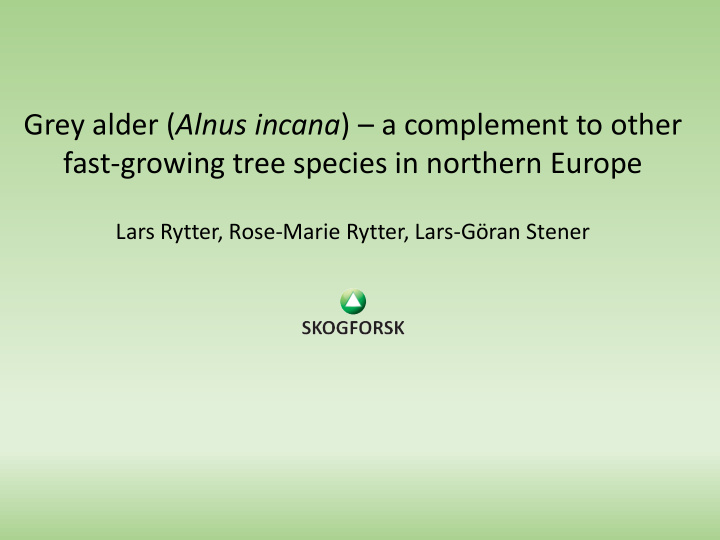



Grey alder ( Alnus incana ) – a complement to other fast-growing tree species in northern Europe Lars Rytter, Rose-Marie Rytter, Lars-Göran Stener
IPC is in the process to include more genera with fast-growing deciduous species into their activities. What will be the effect in northern Europe? Well, one answer could be to include and increase the areas with grey alder ( Alnus incana )
Alders in the Nordic and Baltic countries. Black alder Grey alder ( A. glutinosa ) ( A. incana ) Hultén 1950
Idea : A complement to Populus and Salix species for production of energy wood and for C capture. Grey alder Populus/Salix
Advantages with grey alder : - can withstand harsh climate Christersson & von Fircks 1984
Advantages with grey alder : Ericsson & Lindsjö 1981 - tolerance to low pH conditions Shoot weight (g fw) - does not attract browsing animals Shoot weight (g fw) Birch Grey alder Poplar Without nutrient addition Salix Sennerby-Forsse 1982 Substrate pH
Advantages with grey alder : - is fixing atmospheric N 2 - a native species c. 100 kg N ha -1 yr -1
Disadvantages with grey alder : - almost no breeding has been performed - lower productivity than selected Salicaceae species - unattractive wood for pulp New breeding population
Breeding work : - Seed collection - Research sites Number of trees for respective country and latitude. Lat., °N Country Sweden Estonia Latvia Total 56 10 10 57 17 12 29 58 43 21 3 67 59 6 4 10 60 30 30 61 20 20 62 11 11 63 21 21 64 10 10 65 11 11 66 1 1 67 2 2 Total 182 25 15 222 Rytter & Stener 2015
Breeding work : - Research sites Rytter & Stener 2015
Grey alder productivity – the current situation : 18000 18000 18000 18000 Above-ground woody biomass (g DM -2 ) 16000 Above-ground woody biomass (g DM -2 ) 16000 Above-ground woody biomass (g DM -2 ) 16000 Above-ground woody biomass (g DM -2 ) 16000 14000 14000 14000 14000 12000 12000 12000 12000 10000 10000 10000 10000 8000 8000 8000 8000 6000 6000 6000 6000 4000 4000 4000 4000 2000 2000 2000 2000 0 0 0 10 20 30 40 50 60 0 0 10 20 30 40 50 60 0 0 10 20 30 40 50 60 0 10 20 30 40 50 60 Stand age (yrs) Stand age (yrs) Stand age (yrs) Stand age (yrs) Peak production was reached after 10 – 15 years with 5.5 tons DM ha -1 yr -1 Rytter & Rytter 2016
Current grey alder total production : Biomass production Accumulated Annual mean Distribution (15 years) (Mg ha -1 ) (Mg ha -1 yr -1 ) (%) Stem, branches and stump 82.2 5.48 47.5 Leaves 28.3 1.88 16.4 Coarse roots 18.6 1.24 10.8 Fine roots 43.4 2.89 25.1 Root nodules 0.4 0.03 0.2 Total 172.9 11.52 100 From Rytter & Rytter 2016 By adding 18 % breeding effect (given from birch estimates) MAI is estimated to 6.5 tons DM of AGWB ha -1 yr -1 at 10 – 15 years age
Current C capture : Tree fraction Standing C sequestration Distribution C stock of C sequestration (Mg ha -1 ) (Mg ha -1 yr -1 ) (15 years) (%) Stem, branches and stump 41.1 2.74 68.3 Coarse roots 9.3 0.62 15.5 Root nodules 0.2 0.01 0.2 Undecomposed leaf litter 1.1 Fine root standing mass 0.8 SOC 9.6 0.64 16.0 Total 62.1 4.01 100 From Rytter & Rytter 2016
Where can grey alder be used in the Nordic and Baltic countries ? Forest land Agricultural land ~61 million ha, 560,000 ha available (Rytter & no estimate of availability Rytter 2016)
Potential for production and C capture on abandoned agricultural land : Country Area Production Energy supply C capture (GWh yr-1) (Mg yr -1 ) (ha) AGWB (Mg yr -1 ) Sweden 50,000 325,000 1,700 235,000 Norway 60,000 390,000 2,050 280,000 Finland 4,000 25,000 150 20,000 Estonia 140,000 910,000 4,750 660,000 Latvia 130,000 845,000 4,450 600,000 Lithuania 180,000 1,170,000 6,150 850,000 2.6 Tg C yr -1 TOTAL~ 560,000 3,670,000 19,000 From Rytter & Rytter 2016
Conclusions : Grey alder has many good qualities that are favourable for cultivation in northern latitudes The biomass production is high, although not on the Populus or Salix level There is a large potential for breeding improvement within the species Grey alder may significantly contribute to reduce the climate change effects by biomass production and C capture in northern latitudes
Recommend
More recommend